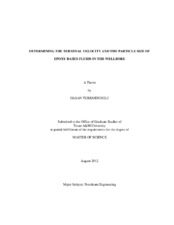Determining the Terminal Velocity and the Particle Size of Epoxy Based Fluids in the Wellbore
| dc.contributor.advisor | Schubert, Jerome J. | |
| dc.creator | Turkmenoglu, Hasan | |
| dc.date.accessioned | 2012-10-19T15:30:23Z | |
| dc.date.accessioned | 2012-10-22T18:04:31Z | |
| dc.date.available | 2014-11-03T19:49:15Z | |
| dc.date.created | 2012-08 | |
| dc.date.issued | 2012-10-19 | |
| dc.date.submitted | August 2012 | |
| dc.identifier.uri | https://hdl.handle.net/1969.1/ETD-TAMU-2012-08-11619 | |
| dc.description.abstract | This thesis was inspired by the project funded by Bureau of Safety and Environment Enforcement (BSEE) to study the use of epoxy (or any cement alternative) to plug offshore wells damaged by hurricanes. The project focuses on non-cement materials to plug wells that are either destroyed or damaged to an extent where vertical intervention from the original wellhead is no longer possible. The proposed solution to this problem was to drill an offset well and intersect the original borehole at the very top and spot epoxy (or any suitable non-cement plugging material) in the original well. The spotted epoxy then would fall by gravitational force all the way down to the packer and then settle on top of the packer to plug the annulus of the damaged well permanently. This thesis mainly concentrates on the factors affecting the fall rates and how to correlate them in order to derive an applicable test that can be conducted on the field or lab to calculate the terminal velocity of the known epoxy composition. Determining the settling velocity of the epoxy is crucial due to the fact that epoxy should not set prematurely for a better seal and isolation. The terminal velocity and the recovery for epoxy based plugging fluids were tested by using an experimental setup that was developed for this purpose. The results were also validated by using an alternative experiment setup designed for this purpose. Factors affecting the terminal velocity and recovery of epoxy were studied in this research since the settling velocity of the epoxy is crucial because epoxy should not set prematurely for a better seal and isolation. The study was conducted by using an experiment setup that was specially developed for terminal velocity and recovery calculations for plugging fluids. Results obtained from the experiment setup were successfully correlated to epoxy's composition for estimating the terminal velocity of the mixture. | en |
| dc.format.mimetype | application/pdf | |
| dc.language.iso | en_US | |
| dc.subject | Epoxy Polymers | en |
| dc.subject | Fall Rate | en |
| dc.subject | Plugging | en |
| dc.subject | Offshore Wells | en |
| dc.subject | Terminal Velocity | en |
| dc.title | Determining the Terminal Velocity and the Particle Size of Epoxy Based Fluids in the Wellbore | en |
| dc.type | Thesis | en |
| thesis.degree.department | Petroleum Engineering | en |
| thesis.degree.discipline | Petroleum Engineering | en |
| thesis.degree.grantor | Texas A&M University | en |
| thesis.degree.name | Master of Science | en |
| thesis.degree.level | Masters | en |
| dc.contributor.committeeMember | Sun, Yuefeng | |
| dc.contributor.committeeMember | Beck, Frederick G. | |
| dc.type.genre | thesis | en |
| dc.type.material | text | en |
| local.embargo.terms | 2014-10-22 |
Files in this item
This item appears in the following Collection(s)
-
Electronic Theses, Dissertations, and Records of Study (2002– )
Texas A&M University Theses, Dissertations, and Records of Study (2002– )


